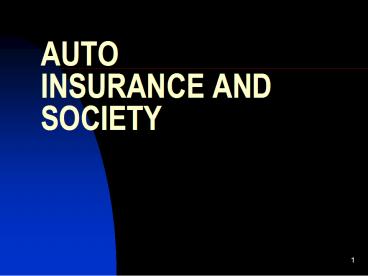AUTO INSURANCE AND SOCIETY - PowerPoint PPT Presentation
1 / 13
Title:
AUTO INSURANCE AND SOCIETY
Description:
Every licensed driver must have auto liability insurance to operate a vehicle ... voluntary market from mainline insurers such as State Farm, Allstate, GEICO, etc. ... – PowerPoint PPT presentation
Number of Views:150
Avg rating:3.0/5.0
Title: AUTO INSURANCE AND SOCIETY
1
AUTO INSURANCE AND SOCIETY
2
COMPENSATING AUTO ACCIDENT VICTIMS
- Compulsory Insurance Laws
- Every licensed driver must have auto liability
insurance to operate a vehicle - Physical Damage is not required
- Enforcement Issue
- In many states, 10 or more of the drivers do not
carry insurance - Financial Responsibility Laws
- Proof after the accident or conviction
- Usually moderate amounts such as 25K per person
and 50K per accident for liability - Unsatisfied Judgment Funds
- Uninsured Motorists Coverage
- No pay- no play
- Uninsured driver cannot sue negligent drivers for
non-economic damages - No Fault Insurance
3
Auto Insurance Plans and Non-Standard Auto
Insurers
- The system must make insurance available to
everyone qualified to purchase it - Most people purchase insurance in the voluntary
market from mainline insurers such as State Farm,
Allstate, GEICO, etc. - For higher risk insureds, there are non-standard
auto insurers who specialize in this business - Higher rates
- More severe merit rating
- Payment plans
- For insureds that cannot obtain insurance in the
voluntary market, they can obtain auto insurance
in the Auto Insurance Plans - Industry run systems for allocating insureds to
participating companies - Uniform rates, contracts, and payment plans
- Everything else by company
4
Restrictions on Rating Variables
- State requirement is that rates cannot be
inadequate, excessive, or unfairly
discriminatory - Class rating uses age, sex, marital status, use,
accident and conviction history, credit score and
other variables to rate - Actuarial data must support use of these rating
factors - Statistical connection rather than a causal
connection - Since auto insurance is at least encouraged to be
purchased by the state, the state has an interest
in what rating variables are used - Different restrictions by state
5
RATEMAKING
6
OBJECTIVES OF RATEMAKING
- Distribute premium charges fairly across all
risks insured - Provide for appropriate premium to cover losses,
expenses, and profit - Minimize the change in premium from one period to
the next to minimize renewal churning (renewal
to renewal change) - Loss prevention
- Satisfy state regulations and so gain approval
- Not inadequate, excessive, or unfairly
discriminatory - Others
7
TYPES OF RATEMAKING
- Based on as many statistics as are available for
the type of risk insured - Types of ratemaking
- Judgmental
- Underwriters play key role
- Used for large and unusual risks such as bridges
and tunnels, special events, and so on - Not statistically based for the most part
- Class rating
- Sufficient statistics to separate risks into a
number of classes - Young drivers/adult drivers
- Drivers without convictions/ drivers with
convictions - Business use/pleasure use
- Underwriters determine the definition of a
class/category and into what class a risk goes - Actuaries use loss statistics to determine the
necessary rate to charge - Used for the mass market lines auto, homeowners,
workers compensation - Merit rating
- Schedule rating
- Experience
- Retrospective rating
8
KEY TERMINOLOGY
- Exposure one unit of risk to be transferred-e.g.
one car for one year - Annual premium the amount to be charged for one
exposure per year - Incurred loss the amount of claims payment
including all reserves - Pure Premium the expected losses per exposure
per year incurred loss/exposure - Example the pure premium for one car insured for
one year is 600
9
Methods of class ratemakingpure premium
- Pure Premium premium must provide for the
average insured loss per exposure and then be
loaded for all expenses, contingencies plus
profit - Example 10,000 cars with 6,000,000 in total
losses expenses at 20 of premium - 6,000,000/10,000 600 pure premium
- 600/.80 750 final premium loaded for losses
- Therefore, premium per car is 750 to cover all
losses and expenses
10
Methods of class ratemakingloss ratio
- Loss ratio incurred losses/ premium
- Permissible loss ratio proportion of premium
devoted to losses, generally 1- expense ratio - Rate level change incurred loss ratio in
experience period/ permissible loss ratio - Example for 2007 the loss ratio is 75 and the
expense ratio is 20 - The projected loss ratio is 75 without a rate
change - The permissible loss ratio is 80- that is, 20
of the premium is devoted to expenses and 80 is
devoted to losses - Then the rate change is 75/80-1 .9375 1
-.0625
11
RATEMAKING ISSUES STATISTICS
- Source of the statistics
- Statistical plan
- Defined plan for each class if business
- May be at company level or at industry level
- Economies of scale for a large company
- Insurance Services Office
- National Council on Compensation Insurance
12
RATEMAKING ISSUES ADJUSTMENTS
- Estimate of incurred losses
- Loss reserving
- The shorter the tail the better the estimate
- Loss development
- Problems with long tailed lines
- Inflation and Trend
- Losses must be adjusted to the level for the time
period the rates are in effect - What inflation factor to use
- CPI
- Company data on loss trend changes
- How long a period should the losses be adjusted
for? - Midpoint of experience period to time when
average loss will occur - Removal of non-repeating or non-allowed expenses
- Punitive damage awards
- Campaign contributions
- Other
13
CASE STUDY RATEMAKING FOR PERSONAL AUTOMOBILE
INSURANCE































